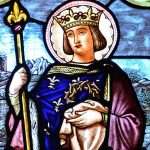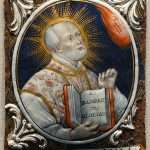Paris Beautiful Churches, Cathedrals and Chapels Heritage
PARIS CHURCH : France’s rich history intertwines the realms of monarchy, religion, and republicanism, each leaving a profound impact on the cultural and political landscape of the nation. From the grandeur of Parisian churches to the turbulent periods of revolution and secularization, the relationship between the Church, kings, and the republic in France is a complex tapestry woven over centuries.
Amazing Catholic Churches in Paris
Paris is home to some of the most breathtaking churches, cathedrals, and chapels, each rich in history, art, and spiritual significance. As a Catholic and passionate guide, Emy offers Christian private tours to help you discover these sacred sites with a deeper understanding. From the iconic Notre-Dame Cathedral, with its stunning Gothic architecture, to the majestic Sacré-Cœur Basilica, offering panoramic city views, these sacred sites captivate visitors. Discover the exquisite stained glass of Sainte-Chapelle, the grandeur of Saint-Sulpice, and the hidden gems of lesser-known chapels. Whether for worship, history, or architectural beauty, these magnificent landmarks offer an unforgettable experience.
Faith-Based Travelers Paris Private Tours
Paris Church, Monarchy and Revolution
The Catholic Church and Monarchy of France
The history of France is deeply entwined with the Catholic Church, which wielded significant influence over both the spiritual and temporal affairs of the nation. For centuries, the Church provided legitimacy to the monarchy and played a pivotal role in shaping political decisions.
Despite the longstanding alliance between the Church and monarchy, the seeds of republicanism began to sprout during the Enlightenment period with Voltaire among others. Ideas of democracy, liberty, and secularism challenged the traditional authority structures, paving the way for revolutionary fervor.
The Revolution of 1789 and Republican ideas
The French Revolution ushered in an era of radical change, marked by the rejection of monarchy and the embrace of republican ideals. The revolutionaries sought to dismantle the authority of both the Church and the crown, viewing them as oppressive symbols of the ancien régime.
Parisian churches bore witness to the upheaval of the revolution, with many experiencing desecration and repurposing for secular ends. The revolutionary fervor unleashed a wave of iconoclasm, challenging the traditional role of religion in French society.
Separation of Church and State in 1905
In the aftermath of the revolution, Napoleon Bonaparte sought to reconcile with the Catholic Church through the Concordat of 1801. This agreement restored some of the Church’s privileges while reaffirming state control over religious affairs, laying the groundwork for a new era of church-state relations.
Subsequent governments pursued policies of secularization, aiming to diminish the influence of religion on public life and promote a more inclusive society. Laws such as the 1905 Law of Separation of Church and State formalized the secular nature of the French Republic.
Paris Church Highlights Private Tours
Embark on a fascinating private and personalized tour that takes you through Paris’s iconic churches, key historical landmarks, and sites connected to the monarchy and the French Republic.
- Cost: From €360 for 1 up to 6 persons – 3 walking hours – USD $375 upon customization
- Duration: Typically 3–6 hours, depending on selected options, your schedule and interests
- In option: Comprehensive Walking or Driving Tour upon your budget and preferences
- Availability: Offered year-round with flexible start times, walking and driving private tours
- Pick-Up/Drop-Off: Convenient pick-up from your hotel or a central Paris location
As a Catholic, Emy provides Paris Christian Tours for travelers in search of a more spiritual trip in Paris or to enjoy they Faith in Paris experiencing mass, adoration and celebrations.
Royal and Republican Landmarks:
- Palais Royal: Learn about its significance in French history and its connection to the monarchy
- Place de la Concorde: Site where the monarchy met its end during the French Revolution
- The Panthéon: Pay homage to the great men and women who shaped the Republic
- Hidden Gems : Discover treasures about Christianity in Paris, capital of France
Paris Birthplace of Gothic Architecture
Visiting The Historic Churches and Cathedrals Of Paris
- No matter what is your religion, you can enter Paris Churches.
- It does not matter if you are not a believer. You come and see.
- Obviously, you do not visit a church like you visit a museum because it is a holy place.
Paris Churches are free to visit and are not visited like a museum
- Be calm and quiet, do not take pictures with a flash, do not touch paintings and sculptures.
- Please, do not disturb mass, celebrations or people in prayers. Peace is important.
- Entrance is free of charge but you are welcome to make a donation and light a candle.
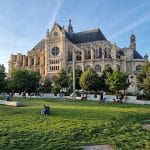
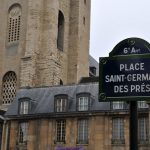
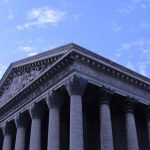

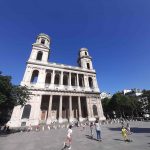
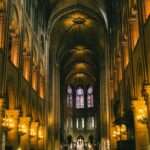
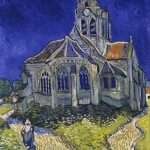
Paris Private Tour Guide
| Pricing | Duration | Number of people | Custom Features |
|---|---|---|---|
| From 240 Euros | 2 hours walking | Up to 6 persons | Hotel pick up |
| From 360 Euros | 3 hours walking | Up to 6 persons | Hotel pick up |
| From 480 Euros | 4 hours walking | Up to 6 persons | Hotel pick up |
| From 850 Euros | 4 hours guide and driver | Up to 6 persons | Hotel pick up |
| Upon quotation | Your choice | Your choice | Your choice |
4-Hour Private Paris Church Driving Tour
From €850 – USD $885 upon level of customization with guide and driver
- Sacred Heart Basilica – Montmartre area
- Notre Dame cathedral – Ile de la Cité area
- Saint Germain des Près church – Saint Germain area
- Sainte Genevieve Relics church – Latin Quarter area
- Saint Eustache church – Les Halles and Le Marais areas
PARIS BY EMY will tailor the experience to suit your preferences.
Top 10 Paris Historic Churches and Cathedrals
The churches of Paris inspire the soul, reflecting the deep ties between the Church and the Kings of France while also witnessing the birth of the Republic through the Revolution.
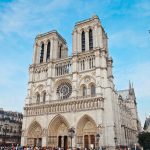
1. The Notre-Dame Cathedral: A Gothic Marvel
The Notre-Dame Cathedral, with its awe-inspiring Gothic architecture, stands as one of the most iconic landmarks in Paris. This masterpiece took nearly two centuries to complete. It holds intricate stone carvings, towering spires, and rose windows. Visitors can marvel at its interior, ascend to the top for a panoramic view of the city.
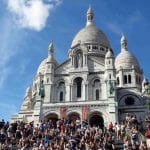
2. The Sacred Heart Basilica of Paris
Perched atop the picturesque Montmartre hill, the Sacré-Cœur Basilica offers a stunning panorama of Paris. This white-domed basilica, constructed in the late 19th century, is a symbol of hope and spiritual devotion. Inside, visitors can admire its grandeur and experience a sense of tranquility in its serene ambiance. A climb up its dome rewards visitors with a breathtaking view of the city’s skyline.
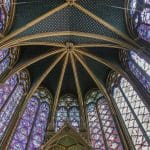
3. Sainte-Chapelle: A Stained Glass Masterpiece
Hidden within the Palais de la Cité, the Sainte-Chapelle boasts extraordinary stained glass windows. Built in the 13th century, King Louis IX commissioned it to house relics from the Passion. Go into a world of vibrant colors as sunlight filters through the stained glass, depicting biblical stories.

4. Saint-Sulpice: A Grand Paris church
Saint-Sulpice, a monumental church located in the heart of Paris, has an impressive façade and magnificent organ. This 17th-century church offers a serene escape from the bustling city, inviting visitors to admire its artistic treasures. As you wander through its chapels, you can appreciate the skill and dedication that went into creating this masterpiece. Delacroix is one of them.

5. The Architectural Madeleine Paris church
The Madeleine Church, resembling a Greek temple, is a striking sight in the heart of Paris. Initially designed as a temple to honor Napoleon’s army, it became a Catholic church. Its grand columns, portico, and interior make it a must-visit destination for those seeking a moment of reflection.

6. Sainte-Trinité: A Symbol of Harmony
Église de la Sainte-Trinité, nestled in the bustling 9th arrondissement, is a testament to architectural harmony. This neoclassical church, designed by Théodore Ballu, combines elements of Greek and Roman architecture with a touch of French influence. Its stunning rose window, dome, and decorations make it a captivating place of worship among different architectural styles.
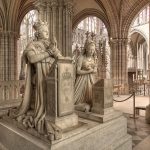
7. Basilica of Saint-Denis: The Gothic Art
Located just outside the city limits, the Basilica of Saint-Denis is the birthplace of Gothic art. This medieval masterpiece, the final resting place of French monarchs, showcases the transition from Romanesque to Gothic architecture. Its intricate stained glass windows, magnificent tombs, and rich historical significance make it a fascinating destination for architecture aficionados.
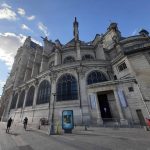
8. Saint-Eustache Paris Church
Saint-Eustache Church, situated in the vibrant Les Halles district, is a harmonious blend of Gothic and Renaissance styles. Its impressive façade, towering nave, and grand organ contribute to its architectural allure. The church’s musical heritage is noteworthy, as it hosts regular concerts, enchanting visitors with the power of music.

9. Saint-Germain-des-Prés: A Historic Haven
Saint-Germain-des-Prés, located in the charming Left Bank neighborhood, is one of the oldest churches in Paris. Its Romanesque architecture and rich history make it a must-visit for those seeking a tranquil retreat. Explore its medieval chapels, stroll through its charming surroundings, and feel the centuries of history come alive.
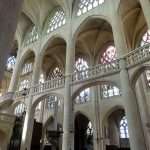
10. Saint-Etienne-du-Mont Paris church
Saint-Etienne-du-Mont, located near the Panthéon, is a captivating blend of Gothic and Renaissance styles. It has a stunning rood screen, and the final resting place of Blaise Pascal. Explore its intricacies, admire its artistic details, and delve into the intersection of faith and knowledge.
Paris Church
Paris is home to some of the most breathtaking churches, rich in history, faith, and architectural beauty. From the gothic structure of Notre-Dame, famous for its flying buttresses and connection to the Da Vinci Code, to the magnificent Sacré-Cœur, a Catholic Basilica standing at the highest point of Paris, each site holds deep spiritual and historical significance.
Step inside the sanctuary dedicated to Jesus Christ at Sacré-Cœur, climb the bell tower for panoramic views rivaling the Eiffel Tower, and learn how these churches endured events like World War II. Through guided tours, you will be welcomed with open arms to explore the heart of Christian heritage in Paris.

Paris Church, Kings and Republics Facts
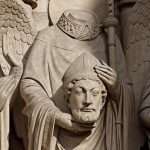
Saint Denis, first Bishop of Paris church in the III century
Saint Denis founded around 245 the first diocese of Paris, called Lutetia at that time. For some historians in the 1st century. Indeed, he was the first bishop of Paris sent by the Pope Saint Etienne, to evangelize the Gaul (Kingdom of France). The story of his life and Passion (story of martyrdom) was written throughout the Middle Ages by many biographers. They gradually transformed history into a legend. When Denis arrived in Paris with two disciples, Rustique and Éleuthère, he preached to the inhabitants and converted them to Christianity.
At that time, Christians were persecuted by the Roman authorities and Paris, named Lutèce, was under the Roman control. Arrested by the Romans, Denis and his companions declared themselves Christians and were beheaded in Montmartre, at the bottom of the Sacred Heart Basilica. To prevent their remains from being thrown into the Seine, a still pagan Roman aristocrat, Catulla, decides to bury them in a field of her property. Later, Christians build a basilica in this place, the foundations of the current Cathedral Basilica of Saint-Denis.
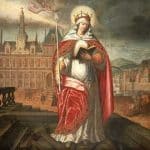
Sainte Patronne of Paris church Sainte Geneviève in the V century
Geneviève (around 420 – 500) is a French saint. For more than 1,500 years, Paris has been under the protection of Saint Geneviève who, through her prayers and her courage, saved the capital from famine and destruction many times.
In 451, the Huns threatened Paris. Geneviève persuaded the panicked Parisians that the Barbarians would not attack the city and it was useless to flee. Indeed, Paris is spared. Then, the Franks came to besiege Paris. Geneviève negotiated with the Franks that the city should not be invaded. It also save Christianity while the Western Roman Empire was doomed to disappear and the barbarian people had embraced Arianism.
The siege by the Franks of Paris lasted 10 years, during which Geneviève forced the blockade on the Seine and supplied the Parisian people with wheat. After the victory of Clovis, the last representative of Roman power in Gaul, she allied with the new king and asked him to convert to Christianity. After his baptism, he reconciled the Franks and Gallo-Roman people.
Paris became the capital of his kingdom in 508. Parisians took the habit, whenever a flood, war or epidemic threatened them, to walk the shrine of the saint. A whole protocol governed this ceremony. Relics found in the crypt of the old Sainte-Geneviève church (nowadays the Panthéon) were placed in 1803 in the Paris Church Saint-Étienne-du-Mont church. These relics of the Saint are the last visible in Paris.
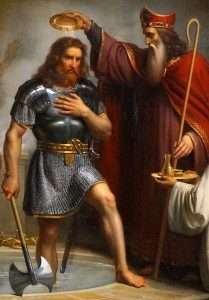
First Christian King Clovis Paris Church in the V century
The first King of France (and of Europe) being baptized is Clovis (465-511) in the cathedral of Reims, region of Champagne. Married to Clotilde a Catholic princess, he was baptized by the Bishop of Reims, future Saint Rémi, on Christmas Day between 496 and 498. Therefore, the King must reign in the name of God. He chose Paris as the capital of his French Kingdom. Clovis established the bases of the Monarchy.
Clovis is the first Christian King in the world. It is one of the most important events in the history of the French monarchy and even of the Catholic Church. This baptism in the Cathedral of Reims remained a significant event : from Henri I all the kings of France, except Louis VI, Henri IV and Louis XVIII, are thereafter crowned in the cathedral of Reims until the king Charles X, in 1825.
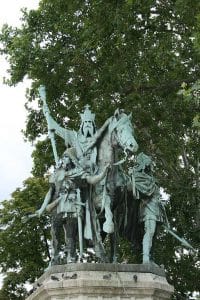
Charlemagne (740 – 814) the king who became emperor
The fall of Rome brings chaos to Western Europe. Carolus Magnus, better known as Charlemagne, sought at all costs to impose radical cultural, economic and religious changes. In nearly half a century of reign, Charlemagne dug the foundations of a new world. He is one of the rare personalities who have influenced the course of universal history.
The king legislated extensively, to improve the daily management of agricultural estates, to impose ecclesiastical reforms and to conform morals – particularly marriage – to Christian canons. He took care to put laws and ordinances in writing to better ensure their application. Its legal texts are called “capitularies” because they are divided into articles or chapters, like current laws. Charlemagne introduced administrative reforms throughout the lands he controlled, establishing key representatives in each region and holding a general assembly each year at his court at Aachen. He standardised weights, measures and customs dues, which helped improve commerce and initiated important legal reforms.
Attentive to religious affairs, Charles, very pious, also took pride in supporting the Pope, head of Western Christianity. In 800 a rebellion against Pope Leo III began. Charlemagne went to his aid in Rome and defeated the rebellion. As a token of thanks, Leo crowned Charlemagne on Christmas Day that year, declaring him emperor of the Romans. Although this did not give Charlemagne any new powers, it legitimised his rule over his Italian territories and attempted to revive the imperial tradition of the western Roman emperor.
The personal reign of Charles I, very long (44 years), was an incessant series of wars against the pagan Saxons of Germany, the Bretons and the Muslims of Spain, who threatened his kingdom on its borders, as well as against the Lombards who threaten the pope. Charlemagne died in 814. His empire did not long outlive him.
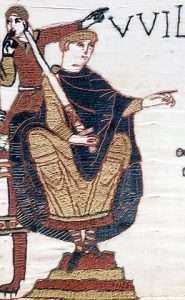
Kings and Paris Church in Middle Ages V to XV century
From 987 to 1328, the Kingdom of France was ruled by the dynasty of the Capetian kings with the support of the Church. During 341 years of the Capetians reign with 14 Kings, the kingdom of France went through crusades, land and religious wars to assert their power and authority accross Europe and the East.
The East–West Schism of 1054, was the break of communion between what are now the Roman Catholic Church and Eastern Orthodox Churches. The Schism was the culmination of theological and political differences between the Christian East and West.
William the Conqueror (Guillaume le Conquérant in French 1027-1087), was king of England from 1066 until his death in 1087 and duke of Normandy from 1035 until his death. After the death of King Edward, he took advantage of a succession crisis to seize the crown of England after his victory at the Hastings Battle in 1066. This conquest made him the one of the most powerful monarchs in Western Europe.
Inquisitio hereticae pravitatis in the Middle Ages
On April 20, 1233, Pope Gregory IX entrusted to an exceptional court called Inquisitio hereticae pravitatis the task of unmasking and condemning, heretics and insincere Catholics, by enforcing penalties for people who did not comply with the dogma. Many emperors and kings assimilated the rejection of the official faith to a crime of lese majesty. They did not hesitate to condemn the culprits to the confiscation of their goods, to the prison even to the death. An estimation of 3,000 death sentences according records were executed during its 5 centuries of existence through Europe.
Along with the inquisition, “witch hunting” was a phenomenon more present in Protestant countries such as Germany, England, Danemark, and less in Catholic countries such as Italy and Spain. The last women executed for witchcraft in Europe is Anna Göldin, sentenced in 1782 in the Protestant canton of Glarus in Switzerland. Historians estimate between 40,000 and 100,000 victims of witch hunting.
The Middle Ages is a period in the history of Europe, extending from the 5th century to the 15th century, which begins with the decline of the Western Roman Empire and ends with the Renaissance and the Great Discoveries. Discover the Museum of Cluny, our National Museum of the Middle Ages in the Latin Quarter, close to Saint Germain.
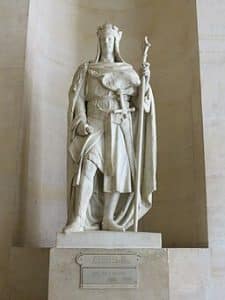
Philip Augustus (1165-1223)
Seventh king of the Capetian dynasty, Philip II known as “Philip Augustus”. King at the age of 15, he was the ruler for 42 years. King Philippe Auguste is one of the emblematic monarchs of medieval France.
Philip was crowned in Reims in his fourteenth year, on November 1, 1179. It took place during the lifetime of his father Louis VII the Young. The following year, on April 28, 1180, he was married to Isabelle of Hainaut, who brought him Artois, Arras and Saint-Omer as a dowry. As his father died on September 18, he was now the sole ruler of France under the name of Philip II.
Despite his marital setbacks, despite also his nervous fragility, he would prove to be a great sovereign through his administrative work and his conquests. He would earn a quadruple of the royal domain. Moreover, he would sometimes earn the nickname the Conqueror. Indeed, Philip Augustus successfully fought the kings of England, Henry II Plantagenet and his sons Richard the Lionheart and John Lackland, who, through their continental possessions (Normandy, Anjou, Aquitaine, etc.), posed a very direct threat to his authority.
The Louvre Palace was a fortified castle built by King Philip Augustus between 1190 and 1202. The goal was to reinforce the wall he had built around Paris to protect the city. It was demolished in stages to make way for the Louvre Palace.
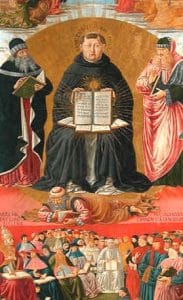
Saint Thomas d’Aquin XIII century
In 1245, Saint Thomas d’Aquin left Italy, clerical and aristocratic privileges to study & teach at the Sorbonne University. The Sainte Ursule de la Sorbonne chapel is decorated in its external front with four niches each comprising a statue. In the upper left, there is Saint Thomas Aquin Statue.
Founded in 1257 by Robert de Sorbon under King Saint Louis, The Sorbonne is an edifice of the former University of Paris. Today, it houses several high education and research institutions. During the 16th century, the Sorbonne became involved with the struggle between Catholics and Protestants. At that time, Kings, Popes would go to study at the University of Paris for its new ideas, visionary leadership and Excellence.
Saint Thomas became and is an immensely influential philosopher, theologian, and jurist in the tradition of scholasticism. He is also known as the Doctor Angelicus and the Doctor Communis. Thomas Aquinas proposed, in the 13th century, a theological work on an attempt to synthesize reason and faith. He distinguishes truths accessible to a single reason, from those of faith, defined as an unconditional adherence to the Word of God. He qualifies philosophy as a servant of theology (philosophia ancilla theologiæ) in order to express how the two disciplines participate in a “subordinate” way in the search for the knowledge of the truth.
King Saint Louis Saint of the Paris church XIII century
Louis IX dit Saint Louis – King of France of the Capetian dynasty, reigned from 1226 to 1270. Saint Louis was the first to give protection to the Eastern Christians against the Ottoman empire. In 1248, he undertook the 7th crusade to save the Latin kingdom of Jerusalem. During these sumptuous years for the country, he also made himself the protector of justice, of peace and of Christianity, while consolidating his royal power.
The main structure of the new Notre Dame cathedral was completed in 1245 under his reign. Moreover, the relics of Christ crucifixion, the crown of thorns, a piece of the cross and a nail, are brought by Saint Louis from Jerusalem in 1239.
Indeed, on August 19, 1239, the relics arrived in procession in Paris. The king abandoned his royal adornment, put on a simple tunic and, barefoot, wore the crown of thorns to Notre-Dame de Paris. To preserve these relics, he built a monumental reliquary, the Paris church Sainte-Chapelle.
The Sainte Chapelle is well-known for its stunning stained glass. Arranged across 15 windows, each 15 metres high (50 foot), the stained glass panes depict 1,113 scenes from the Old and New Testaments recounting the history of the world until the arrival of the relics in Paris. Saint Louis also had the Sorbonne built in 1257. Louis IX called Saint Louis was the only canonized king of France.
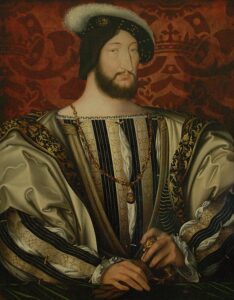
King François I (1494-1547)
Born under the name François d’Angoulême on September 12, 1494 in Cognac and died on March 31, 1547 in Rambouillet, is a king of France who reigned from January 25, 1515, the day of his coronation, to his death in 1547. Son of Charles d’Orléans and Louise de Savoie, he belonged to the Valois-Angoulême branch of the Capetian dynasty.
Indeed, Francis I is considered the emblematic king of the French Renaissance period. His reign allowed a significant development of arts and letters in France. He has a powerful rival in the person of Emperor Charles V (Was Emperor of the Holy Roman Empire (1519-1555) under the name of Charles V of Germany, and King of Spain under the name of Charles I of Spain.
Moreover, he was the most powerful monarch in Europe and must count on the diplomatic interests of King Henry VIII of England (married 8 times and father of Elisabeth 1er), always eager to become an ally of one camp or the other. Francis I forbade his imperial enemy from making his dreams come true. The antagonism of the two Catholic sovereigns had serious consequences for the Christian West: it facilitated the spread of the nascent Reformation and above all allowed the Ottoman Empire to settle at the gates of Vienna.
His reign accelerated the Reformation. The constitution became the absolute monarchy under the Bourbons. The war financial needs led to optimize the management of the State and the territory. Francis I introduced a series of reforms and in particular the improvement of tax yield, reforms implemented and continued under the reign of his son and successor, Henry II. He ordered the construction of Saint Eustache church in Paris.
Chambord castle is also one of the most astonishing Renaissance constructions under François I and Leonardo da Vinci.
Joan of Arc (1412-1431) King Charles VII (1403-1461)
During the Hundred Years’ War, Charles VII inherited the throne of France under desperate circumstances. Forces of the Kingdom of England and the duke of Burgundy occupied Guyenne and northern France, including Paris, the capital and most populous city, and Reims, the city in which French kings were traditionally crowned. In addition, his father, Charles VI, had disinherited him in 1420 and recognized Henry V of England and his heirs as the legitimate successors to the French crown. At the same time, a civil war raged in France between the Armagnacs (supporters of the House of Valois) and the Burgundian party (supporters of the House of Valois-Burgundy, which was allied to the English).
With his court removed to Bourges, south of the Loire river, Charles was disparagingly called the “King of Bourges”, because the area around this city was one of the few remaining regions left to him. However, his political and military position improved dramatically with the emergence of Joan of Arc as a spiritual leader in France. Declared a heretic, but still authorized to receive communion, Joan of Arc was delivered to the English, who put her to death on May 30, 1431 on the pyre raised by them on the Place du Vieux-Marché, in Rouen.
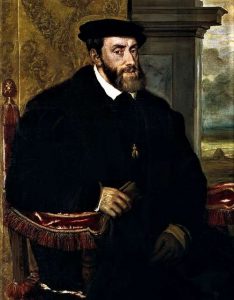
King Charles V (1500–1558)
Charles V (1500–1558) was Holy Roman Emperor and Archduke of Austria from 1519 to 1556. He also was King of Spain from 1516 to 1556, and Lord of the Netherlands as titular Duke of Burgundy from 1506 to 1555.
Charles revitalized the medieval concept of universal monarchy. With no fixed capital, he made 40 journeys through the different entities he ruled and spent a quarter of his reign travelling within his realms. Although his empire came to him peacefully, he spent most of his life waging war, exhausting his revenues and leaving debts. Indeed, he attempted to defend Catholicism, the integrity of the Holy Roman Empire from the Reformation, the expansion of the Ottoman Empire, and in wars with France.
The Charles V wall, built from 1356 to 1383, is one of the seven large walls that chronologically surrounded Paris. It replaced that of Philippe Auguste on the right bank. Its western part, which had become useless after the construction of the Louis XIII wall. However, it was demolished around 1640. Its eastern part, reinforced by the creation of bastions in the middle of the 16th century. Then, it was destroyed from 1670, making way for the Grands Boulevards. This rampart, has very few remains.
Saint Ignace de Loyola vow in Paris church XVI century
Ignatius of Loyola (1491 – 1556) in Rome, was a Basque-Spanish priest and theologian, founder and first Superior General of the Society of Jesus. He assumed considerable tasks in the reaction of the Roman Catholic Church in the 16th and 17th centuries, facing the Protestant reform.
On August 15, 1534, at the end of the mass celebrated in Montmartre in the crypt of the Saint Denis martyrium, he pronounced with 6 other priests the 2 vows of poverty and chastity. It was the first act of an apostolic project giving birth of few years later the Society of Jesus, approved by Pope Paul III in 1540.
Pope Francis (François in French) is the first pope from the ranks of the Society of Jesus, the first non-European pope since the Syrian pope Gregory III in the 8th century. He is also the first pope to take the name of Francis, a name chosen in memory of Saint Francis of Assisi (1181 or 1182 -1226). The Catholic Paris church of Saint-François-d’Assise is located rue de Mouzaïa in the 19th arrondissement of Paris. Saint Francis of Assisi is regarded as the precursor of inter-religious dialogue.
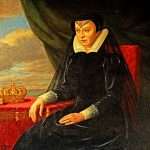
Queen Catherine de’ Medici Paris church war in the XVI century
Catherine de’ Medici 13 April 1519 – 5 January 1589) was an Italian (Florentine) noblewoman born into the Medici family. She was Queen of France from 1547 to 1559 by marriage to King Henry II and the mother of French kings Francis II, Charles IX, and Henry III. The years during which her sons reigned have been called “the age of Catherine de’ Medici” since she had extensive, if at times varying, influence on the political life of France.
In France, wars of Religion are called a series of 8 conflicts (civil wars, wars of religion and military operations) which ravaged the kingdom of France in the second half of the 16th century and where Catholics and Protestants (also called Huguenots ) opposed.
The spiritual Protestant was Jean Calvin, French theologian, pastor and reformer. The St. Bartholomew’s Day massacre (French: Massacre de la Saint-Barthélemy), unleashed on the night of August 24, 1572 in Paris, is the culmination of the political and religious crisis which has opposed Catholic elites to Protestant elites for ten years.
Historians have long remained divided on the exact role of the crown. The historical tradition made King Charles IX 4th king of the Valois-Angoulême family and his mother, Catherine de Medici, the main culprits of the massacre. In Paris, the executions of thousands of Protestants by Catholics take place over several days in Paris. The signal given from the Paris church Saint Germain l’Auxerrois, a Paris church near by the Louvre.
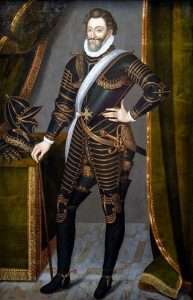
The Edit de Nantes by King Henri IV in the XVI century
Another major event is the Edit de Nantes by King Henri IV. To access the throne, Henri de Navarre Protestant Chief at that time, had to convert to Catholicism. On July 25, 1593 Henri de Navarre abjured Protestantism for the last time in Basilica of Saint-Denis, near Paris. The basilica became a place of pilgrimage and the burial place of the French Kings with nearly every king from the 10th to the 18th centuries being buried there. This condition fulfilled, he ends up imposing himself as king of France under the name of Henri IV, installing a new dynasty, that of Bourbons.
The Edict of Nantes is an edict of tolerance promulgated in April 1598 by the King of France Henry IV, to put an end to the Wars of Religion which had ravaged the Kingdom of France since 1562, and particularly to the Eighth War, which began in 1585. Thanks to the Edit de Nantes, Henri IV ended decades of civil war, pitting Catholics against Protestants. It is undoubtedly the most important act of his reign.
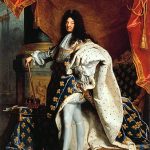
The Edit de Nantes revocation by King Louis XIV in the XVII century
Louis XIV, known as “Louis the Great” or “the Sun King”, (1638-1715) is a king of France. His reign of 72 years is one of the longest in the history of Europe and the longest in the history of France. From 1682, Louis XIV ruled his kingdom from the vast Palace of Versailles.
On October 18, 1685, Louis XIV, the Sun King, the 44th king of Navarre and the third king of France from the Bourbon dynasty, signs the Edict of Fontainebleau. This act, which revokes the Edict of Nantes signed on April 13, 1598 by Henri IV, his grandfather, prohibits the existence of the Protestant cult in France. The Sun King, eager for absolutism and centralization, tried to stifle the practice of Protestant worship. After “Moderate Politics”, it will authorize persecution, causing a demographic hemorrhage, disastrous for the country’s economy and which will weaken the kingdom.
In Versailles, the Royal Chapel was completed at the end of the reign of Louis XIV in 1710. Dedicated to Saint Louis, patron saint of the King, the royal Chapel echoes the Sainte-Chapelle Paris church built under Saint Louis king.
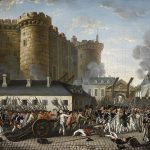
The French Revolution of 1789 and Paris Church
The French Revolution from 1789 caused a massive shift of power from the Roman Catholic Church to the State. Under the monarchy, the Church had been the largest single landowner in the country. In addition, the Church was exempt from paying taxes to the government, while it levied a tax often collected in the form of crops on the people.
Louis XVI died with the guillotine on January 21, 1793. Nine months later, Marie Antoinette was also convicted of treason and beheaded on October 16.
The French Revolution brought the Republic model, in which power is exercised by elected persons. Slavery by royalty and clergy on people (named the serf) and their privileges have been dismantled. The prohibition of trafficking only intervened in 1815. Slavery was definitively abolished in Paris, in the Council of Government, by the decree of Victor Schœlcher who decided the abolition of slavery in France and in its colonies, on April 27, 1848. It also decriminalized homosexual relations as early as 1791. Moreover, France was the first to grant full equal rights to Jews through the vote of the Constituent Assembly in 1791 at the start of the French Revolution.
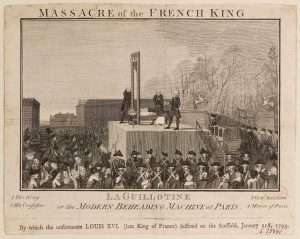
The Terror and Paris Church
During the Revolution’s Reign of Terror, the project of de-Christianisation started, including the imprisonment and massacre of priests, religious, royalists or not royalists and destruction of churches and religious images throughout France.
The Picpus cemetery is one of 2 private cemeteries of Paris, with graves from the French Aristocraty. It was dug in June 1794 in the garden convent. In 6 weeks, the guillotine killed more than 1,306 people. Overall, several tens of thousands are guillotined, shot or drowned.
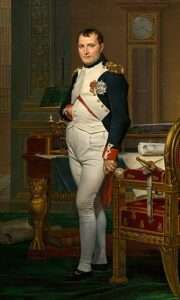
Freedom of religion by Napoléon in 1802
The Terror ended on 9 thermidor year II (July 27, 1794) with the fall of Robespierre. Then, the coup d’état (putsch) on November 9, 1799 took place with the following operations : Napoléon Bonaparte will be commander in Chief of the Army in Paris and in the assemblies. Napoleon coronation as an Emperor, first Emperor of France, on December 2, 1804 took place in Notre Dame Cathedral. Napoléon ended the de-Christianisation. He established the rules for a relationship between the Catholic Church and the French State. In 1802, with the Concordat signed with Pope Pius VII, Napoléon Bonaparte restored freedom of worship. He saw that religion was necessary for the balance of people. Napoléon Bonaparte declared on August 16, 1800:
“My policy is to govern men. This is, I believe, the way to recognize the sovereignty of the people. It was by making myself Catholic that I won the war in Vendée, by making myself Muslim that I established myself in Egypt, by making myself ultramontane that I won minds in Italy. If I ruled a Jewish people, I would restore the Temple of Solomon. “
La Madeleine Paris church, dedicated to Saint Mary Magdalene is a Roman Catholic church in the 8th arrondissement of Paris. Napoleon wanted the Madeleine Church as a temple to the glory of the army. However, he gave it back to the glory of God in 1813.
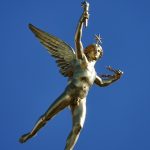
The Republic and the Church
The first Republic in 1792
The République is the form of government in force for the first time in 1792 after Bastille Day. The French Revolution of 1789 then interrupted the republic from 1804 to 1848. Indeed, Napoléon Bonaparte becoming Emperor with the coming back of the constitutional monarchy.
The Second Republic interrupted from 1852 to 1870 with Napoléon III
Second republic then interrupted from 1852 to 1870 with Louis Napoléon Bonaparte, Napoléon III (nephew of Napoléon Bonaparte) second empire. Not respecting his promises to Christians, in 1860, the sultan exercised bloody repression against the Lebanese Maronites, Eastern Christians. For Napoléon III, it was a provocation. An expeditionary force embarked for the current country Lebanon. A year later in 1861, a special status is obtained from Istanbul, with the designation of a Christian governor.
The Communard movement in 1870
The Commune of Paris finds its source in a republican impulse referring to the First Republic and Second Republic. Napoleon III’s high-ranking officials, Baron Haussmann, notes more than half of Parisians live in “poverty bordering on indigence”. In July 1870, the Second Empire began an ill-prepared war against Prussia, which quickly led to defeat. On September 4, 1870, a day of riots in Paris overthrown the Empire.
The communard movement was born following an uprising of Parisians on March 18, 1871. Dominated by the extreme left, the communard are Jacobins, Marxists, independent Blanquists and anarchists.
The Communards want a federalist, democratic and social republic with absolute autonomy for the communes of France. They also wanted a separation of Church and State. However, from Versailles, the propaganda of Adolphe Thiers provoked the rejection of the movement in the countryside.
In the final battle of Bloody Week on May 28, 1871, hundreds of Communards were killed in action. At the same time, the Paris Commune rose up, provoked bloody religious persecution. They used the clergy as bargaining chips. The Versaillese executed around 20,000 communards. Out of 36,000 communards arrested, 4,500 imprisoned. 7,500 deported (mainly to New Caledonia). 10,000 convictions pronounced, including 93 to capital punishment. Indeed, 23 were carried out.
The Third and the Fourth Republic interrupted from 1940 to 1944
The law concerning the separation of the Church and the State is adopted on December 9, 1905. Indeed, it was on the initiative of the republican-socialist deputy Aristide Briand, who took sides in favor of a laicism.
Finally, Paris Vichy government during WW2 interrupted the Third republic from 1940 to 1944. The Fourth Republic followed.
The Fifth Republic since October 4, 1958
The Fifth Republic is in force since October 4, 1958 by Charles de Gaulle, elected its first president. Paris church reflects our history and culture. Paris church tells a story of faith, artistry. Moreover, Parisian churches tell the evolution of architectural styles. If you seek spiritual solace, these churches offer a unique perspective on the city’s cultural tapestry.
Paris church king and republic
Paris, the enchanting capital of France, is renowned for its rich cultural heritage and architectural marvels. The churches of Paris stand as timeless testaments to the city’s deep-rooted religious significance and historical significance. Paris is a Christian stronghold. In addition, you have hundred houses of Christian worship to discover in every district of Paris. Paris church, experience the Holy humanity in the City of Lights.
Have a look at the customized private tour guide in Paris page for more inspirations.


